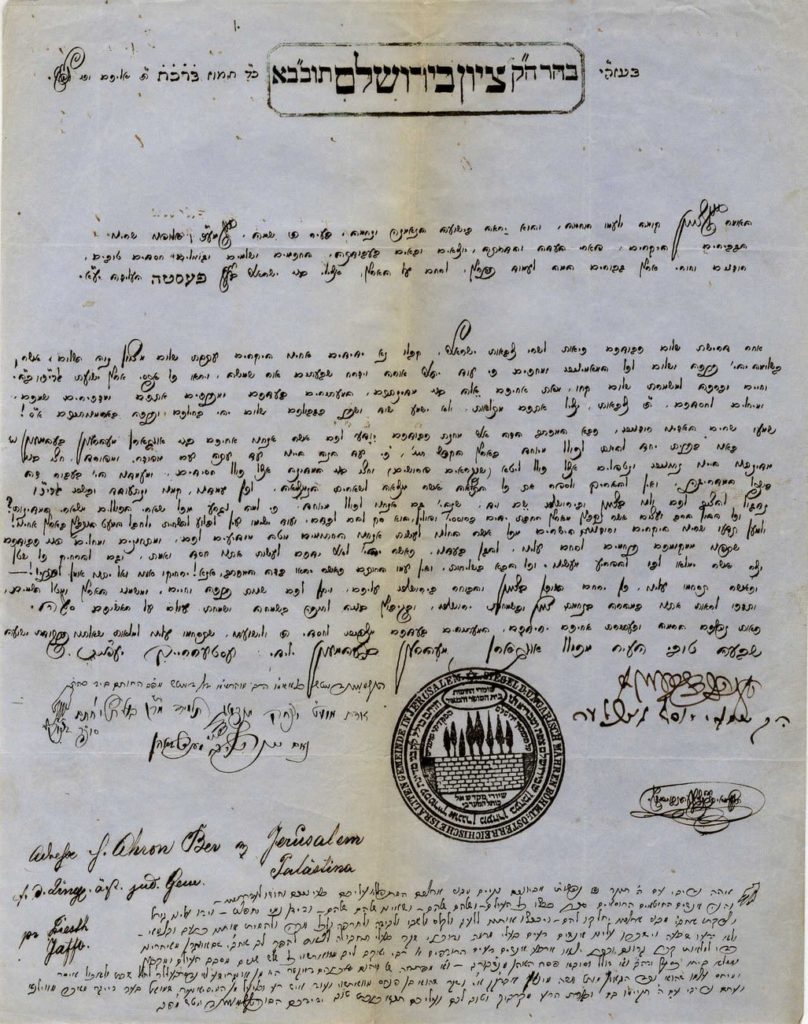
Historic placard explaining the necessity for founding Kollel Ungarin in Jerusalem and in the Land of Israel, despite the opposition of the rabbis of the city. The poster is signed by the founders and leaders of the kollel, prominent disciples of the Chatam Sofer who immigrated to Jerusalem. Jerusalem, 24th of Tammuz, 1862.
Specifications: [1] leaf, 21×28 cm.
Background: Poster of historic importance sent from Jerusalem to the Jews of Pest, notifying the Jews of Hungary that a special kollel had been founded for Hungarian immigrants, so that they would no longer be scattered among the Jerusalem kollels. They detail the manner in which donations will be collected and hint to expected difficulties “to distance all those agitators whose hearts want to interfere,” which is what did happen in the battles between the kollels.
A large stamp of “Shomrei HaChomot Beit HaSofer V’HaMeir,” as it was then called, is at center of the poster. Today it is known as “Kollel Shomrei HaChomot:” Kollel for immigrants from the states of Osterreich, Ungarin [Hungary], Mahren (Moravia) and Bohemen in Jerusalem, Safed and Tiberias. Signed by seven elders of the city, prominent disciples of the Chatam Sofer who immigrated to Jerusalem:
Rabbi Shimon Deutsch, beloved disciple of the Chatam Sofer, known for having copied complete compilations of Torah thoughts from his great teacher, and printing some of them as books. He immigrated to Jerusalem in 1842 and authored Zivchei Tzedek, Imrei Shefer, Beracha Metzuyan and more. He was a head of the kollel. Rabbi Deutsch’s son-in-law, Rabbi Moshe Nachum Wallenstein, one of the heads of the kollel. Rabbi Yitzchak Prag-Prager, who signs אדם מוע”ט. Rabbi Yonah Leib Mendelsohn who immigrated to Jerusalem in his youth, per his rabbi’s advice. He was a leader of the kollel and traveled on fundraising missions on its behalf. Rabbi Shmaya Yosef Gintzler, who immigrated from Ujhely to Jerusalem in 1860, and more.
Condition: Fine. Small tears and minimal aging stains. Fold marks.
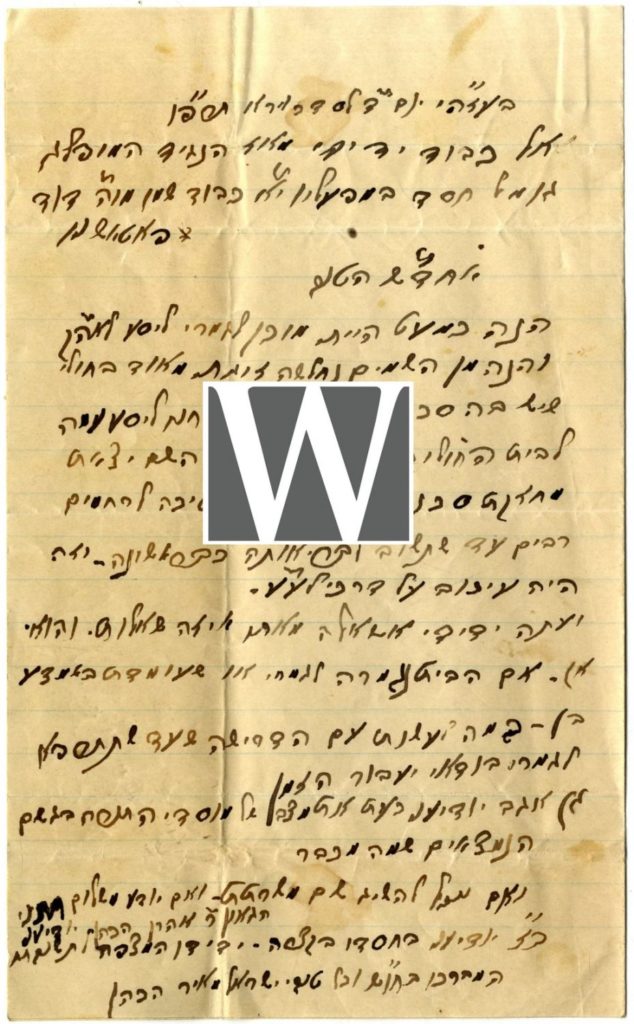
Letter handwritten by the Chafetz Chaim in [1926] regarding his planned immigration to the Land of Israel and questions regarding the house being constructed for him in Petach Tikvah.
Background: The Chafetz Chaim’s greatest dream and desire was to move to the Holy Land. He was imbued with this longing and yearned to settle the Land. Already in 1880, he made a condition with his son-in-law that though he was taking responsibility for supporting him, his son-in-law would not be able to prevent him from moving to the Land of Israel. He did the same with all of his sons-in-law, and made the same condition in 1903, when he married his second wife, Miriam Frieda. However, his mammoth efforts and worries on behalf of his yeshiva and the Torah institutions in the Diaspora prevented him from fulfilling his dreams. Upon the establishment of the “Vaad HaYeshivot,” which the Chafetz Chaim viewed as an economic anchor for yeshivot, he once again attempted to fulfill his dreams and immigrate to the Holy Land. When the Lithuanian rabbis heard about this decision, they gathered in the home of Rabbi Chaim Ozer Grodzinsky, Av Beit Din of Vilna, and decided to ask the Chafetz Chaim to push off his trip in order to further strengthen the Vaad HaYeshivot with his influence. Rabbi Chaim Ozer’s request bore fruit, and the Chafetz Chaim pushed off his trip until Rosh Chodesh Elul, 1925. That is when he sent a farewell letter to his brethren in the Diaspora and packed his belongings for the trip. However, he was again visited by another delegation of Roshei Yeshiva, headed by Rabbi Baruch Ber Leibowitz. Rabbi Leibowitz cried mournful tears and begged the Chafetz Chaim to stay in Europe at least until after Sukkot to assure the continued existence of the yeshivot. The Chafetz Chaim assented and pushed off his trip until the very last day that his travel documents were valid – Tuesday, Parshat Lech Lecha, 1926.
Specifications: [1] lined paper. 21×13 cm. The entire letter – all 22 lines – was written and signed by the Chofetz Chaim. All the text is clear and legible.
Unique Features: This rare letter from the Chafetz Chaim relates to this point in the story of his attempts to immigrate. It was written on Wednesday of parshat VaYera 1926, and it provides a detailed description of the chain of events that prevented him from moving to the Holy Land until then, and includes a request to clarify a few things that were important to him.
“I was almost completely ready to travel to the Holy Land,” Rabbi Yisroel Meir HaKohen relates. “And now, it was Heavenly ordained that my spouse became very weak with a disease with clear danger, and we were forced to travel with her to the hospital in Vilna. With G-d’s compassion, she is no longer in danger, but she still needs mercy … and this is what delays me right now.”
The Chafetz Chaim asks for clarification regarding a few details:
1> Is the house being constructed for him in Petach Tikvah complete, or still in the middle of construction? 2> What can be done about the immigration certificate that expired while his wife was recuperating? 3> What is the physical condition of the Torah institutions in Petach Tikvah? 4> Is it possible to hire a maid? 5> How is his son-in-law, Rabbi Aharon HaKohen?
The end of the story is well known. His wife recuperated that year (refer to Shnot Dor V’Dor , section 1, p. 292), and they were able to procure new certificates. However, the day they arrived, his daughter became ill. And after that, his doctors advised the Chafetz Chaim that the long journey was dangerous in his poor health and old age. The Chafetz Chaim made peace with staying in Europe and said that the trip was being intercepted from the Heavens (refer to HaChafetz Chaim U’Pualo , by M. M. Yashar, section 2, p. 608-617).
Apart from this letter’s being historic, written and signed by the Chafetz Chaim and discussing an idea that was so close to his heart – his wish to live in the Holy Land and serve Hash-m in peace and quiet in a small settlement absorbed with the holiness of the Land of Israel, it is a spiritual asset and a tremendous merit for the one who keeps it in his home, as expressed by the addressee.
This is apparently one of the most unique, important letters known today written in the hand of Rabbi Yisrael Meir HaKohen of Radin, author of the Chafetz Chaim and Mishna Berura .
Additional letter: The Chafetz Chaim’s house in Petach Tikva. When the Chafetz Chaim considered moving to the Land of Israel, he decided to settle in a small village, in the Mother of the Settlements, Petach Tivka. The communal activists built a home especially for him, fundraising for its construction from donors around the world. This lot includes a letter dated Kislev 1926, from Rabbi Dov Ber Abramowitz, Av Beit Din of St. Louis and then in Jerusalem. The letter is addressed to an American philanthropist and notes that they are $1000 short “of completing the home of the righteous person, the pillar of righteousness in our generation … and know the building is almost finished … and the check will help us very much. Because the righteous one of our generation, the Chafetz Chaim shlit”a is about to travel here, and he asked if the home is finished, as your honor will see in the Chafetz Chaim’s letter that is enclosed here … to enhance the home of the righteous person whose name will be a designated place for Torah, sanctity and purity.” The letter notes that the great rabbi’s merit will certainly protect everyone who assists in this manner. The letter is also signed by Rabbi Yisrael Aharon Braverman, in the name of his father Rabbi Zerach Braverman. The house was completed and a celebration was held for the “Chanukat HaBayit” (refer to Zichron Shlomo , Jerusalem 1972, p. 23). Since the Chafetz Chaim did not merit to move to the Land of Israel, the house on Montefiore Street was transferred to the Lomza Yeshiva that is nearby. Today the Birkat Yaakov Talmud Torah uses the building. Background: The addressee, Rabbi David Potash, was a confidante of the Torah leaders, and the Chafetz Chaim chose him to help him procure the immigration documents and settle in the Land of Israel. In the margins of Rabbi Abramowitz’s letter, he asks, “Please return the letter from Rabbeinu HaTzaddik shlit”a, because Rabbi David Potash wants to retain the letter as a spiritual asset.”
Condition: Fine-very fine. Solitary light stains. Minimal creases.
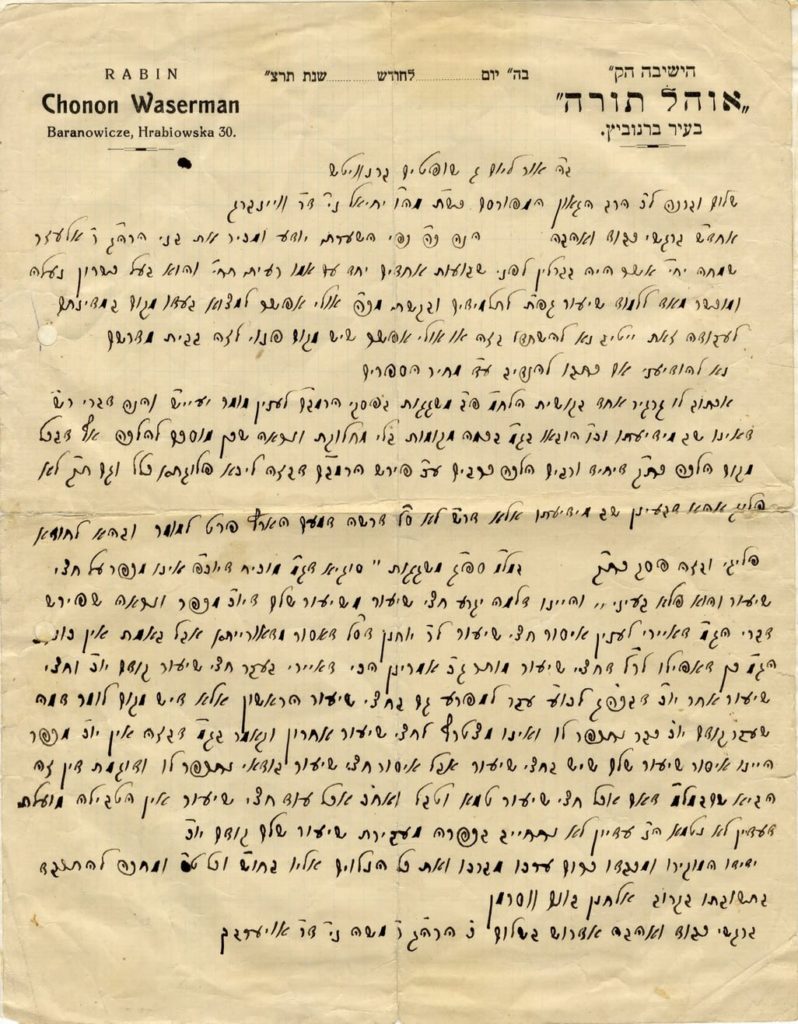
Long letter from Rabbi Elchanan Wasserman to Rabbi Yechiel Ya’akov Weinberg of Berlin, the author of the Sridei Esh. Baranovich [early 1930s].
Specifications: [1] leaf, official paper, 27×21 cm. 23 lines in his holy handwriting and with his signature, clearly and legibly written.
Unique characteristics: Letters containing Torah novellae by Rabbi Elchanan Wasserman are particularly rare.
Background: In the letter, Rabbi Elchanan Wasserman writes about his son Rabbi Elazar Simcha, who has a superior ability to teach students lessons in Gemara, Rashi, and Tosefot, and requests if it is possible to find him a place in their Beit Midrash. Later on, he writes Torah novellae at length on the topic chetzi shiur baYom HaKippurim .
Rabbi Elchanan Bunam Wasserman [1875-1941] Rosh Yeshiva of Ohel Torah in Baranovich, was one of the leading rosh yeshivas and Torah instructors in Lithuania in the generation preceding the Holocaust. He was the right hand man of the Chafetz Chaim in preserving the foundations of religion, and intense activist in Agudat Israel. His scholarly books Kovetz Hearot and Kovetz Shiurim are inalienable assets in the yeshiva world.
Condition: Fine – very fine. The letter was slightly restored without damage to the text. Binder hole-punched, causing damage to two letters. Fold marks.
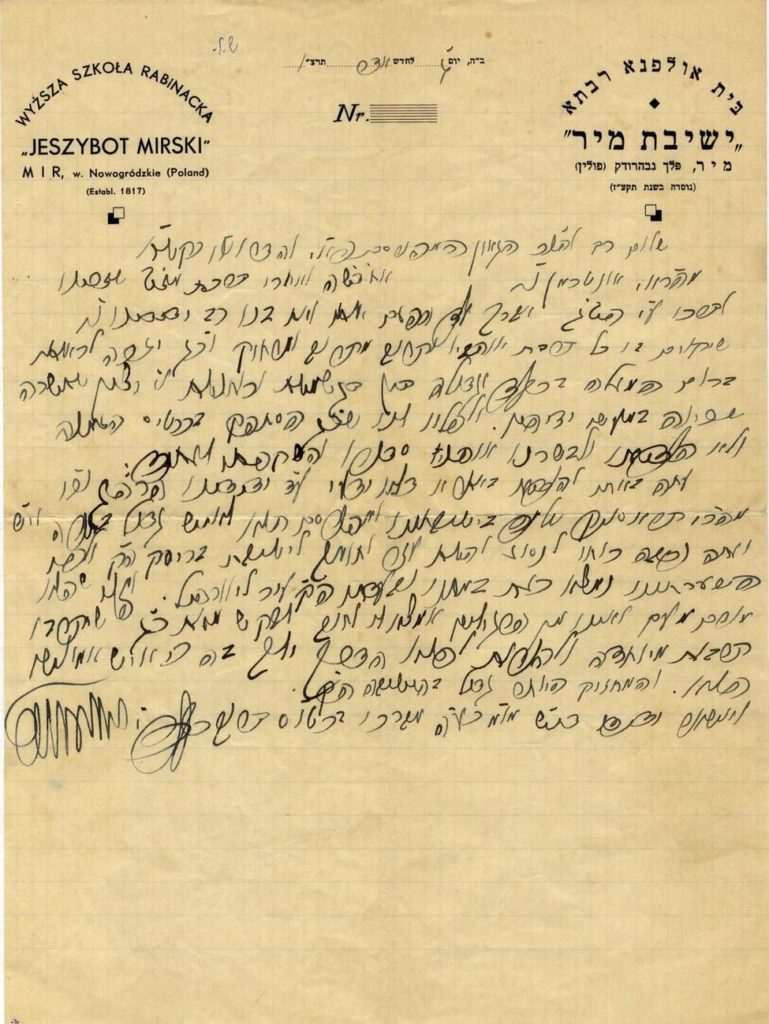
Letter from Rabbi Yeruchem HaLevi Levovitz, famed “Mashgiach” of the Mir Yeshiva. 1936.
Specifications: [1] leaf, letterhead of the Mir yeshiva. 27×20 cm. 15 lines, all in his hand and with his signature. The letter was sent to Rabbi Isser Yehuda Unterman, who moved to England to serve as rabbi of Liverpool, per the suggestion of Rabbi Chaim Ozer Grodzinski. The letter was written during the final months of Rabbi Levovitz’s life, right before he fell ill. This may be the last letter he ever wrote.
Background: Rabbi Yeruchem HaLevi Levovitz was a prominent mashgiach and mussar proponent. He was born in 1874, and educated in the yeshivas of Slobodka and Kelm. His teachers were Rabbi Nosson Tzvi Finkel (the “Alter of Slobodka”) and Rabbi Simcha Zissel Ziv (the “Alter of Kelm”). He later transferred to study in the Chofetz Chaim’s “Kollel Kadshim” in Radin, until he was appointed Mashgiach in the yeshiva there. He was later chosen by Rabbi Eliezer Yehuda Finkel to serve as Mashgiach in the Mir Yeshiva. He served in the position for decades and accompanied the yeshiva during stormy periods and various wanderings. He was also mashgiach in other yeshivas. He taught many disciples, including many prominent Torah leaders who considered themselves his dedicated students. Though he was Lithuanian (“litvish”) his students and admirers referred to him as their Admor (“rebbe”). He passed away in 1936 and his Torah thoughts and lectures were recorded in many works.
Condition: Very fine. Fold marks.
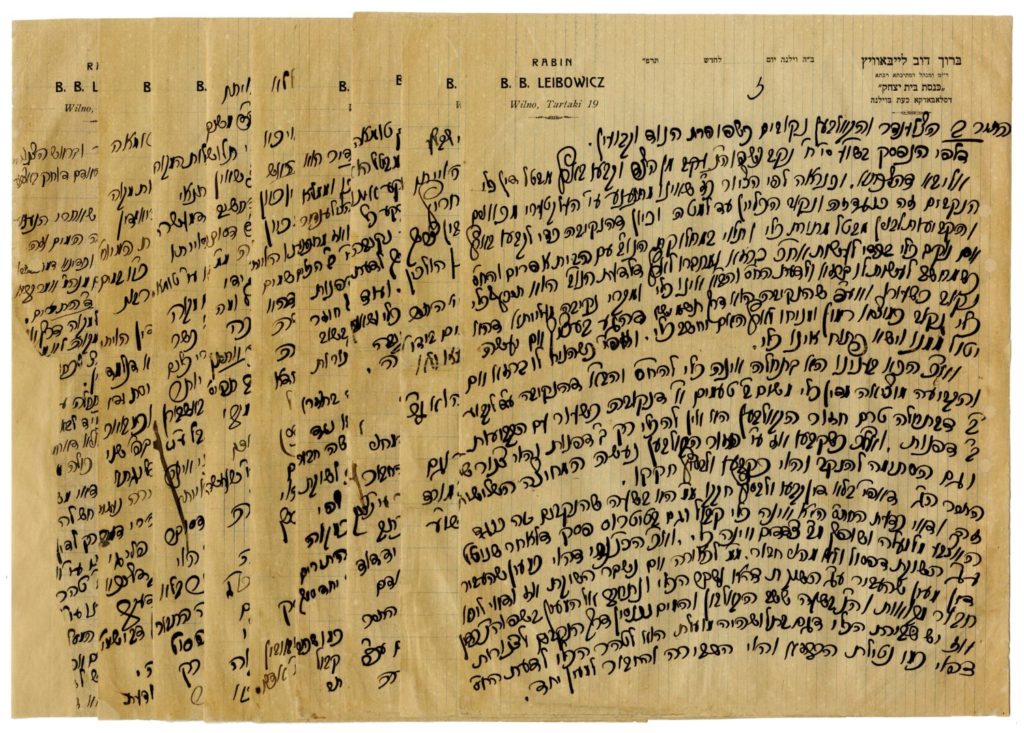
Long Halachic Responsum by Rabbi Baruch Dov [Ber] Leibowitz, written at the request of Rabbi Chaim Ozer Grodzinski. [Vilna, 1926].
Specifications: Nine leaves, ink on official stationery. 22×28 cm. Entirely in his handwriting, clear and legible.
Unique characteristics: Halachic responsa from Rabbi Baruch Dov Leibowitz are extremely rare. On page 6 of the responsum before us, he even took the time to add an illustration to enhance the understanding of the topic.
Background: Halachic responsum about a mikvah in which the spring water entered through an underground pipe by electric pump. Rabbi Baruch Dov Leibowitz decides to rule leniently under certain conditions. The question was initially addressed from Alsace, Germany to Rabbi Yechiel Yaakov Weinberg of Berlin.
Rabbi Weinberg, who advocated permitting it, referred the question to Rabbi Chaim Ozer Grodzinski and Rabbi Moshe Mordechai Epstein. Rabbi Chaim Ozer Grodzinski wrote to Rabbi Weinberg, saying that during a meeting of a committee of rabbis, he spoke with them about the question. Rabbi Baruch Dov Leibowitz wrote an answer on the matter, and this is the responsum before us. Material on the matter is attached. The responsum was printed in the memorial book for Rabbi Yechiel Yaakov Weinberg.
Rabbi Baruch Ber Leibowitz (1870-1939), was the head of the yeshiva “Knesset Beit Yitzchak” in Slobodka, which moved to Vilna and then to Kamenitz. Rabbi Baruch Ber was one of the greatest disciples of Rabbi Chaim of Brisk, and one of the greatest Torah teachers of his generation. He wrote the Birkat Shmuel series of books which are among the cornerstones of yeshiva study to this day.
Condition: Fine. The pages were slightly restored, and except for a tear on the first page that damaged the text, all the text on the rest of the pages is legible and clear.
.
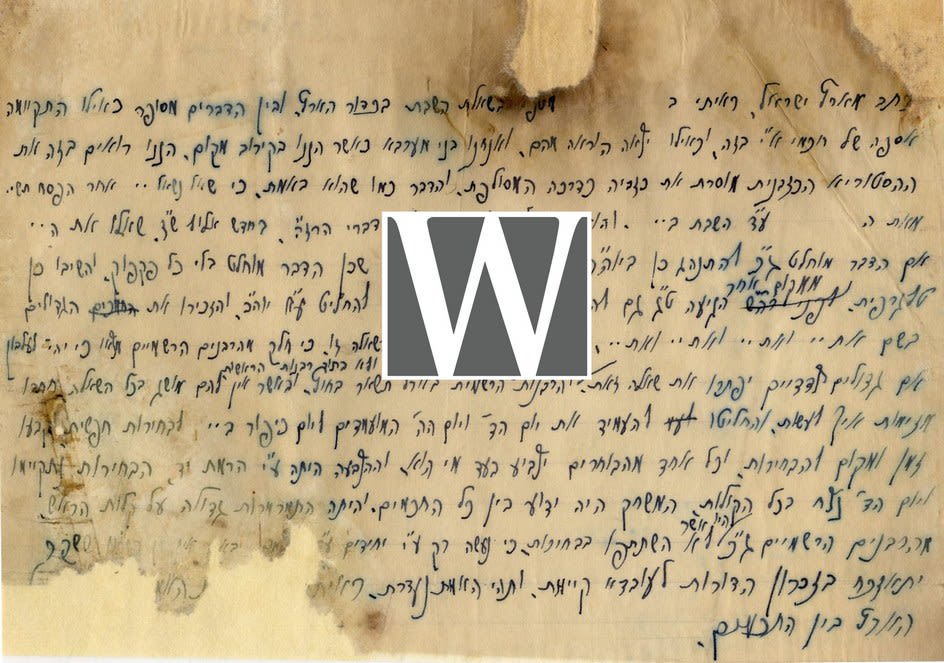
The Chazon Ish’s opinion about the session convened by the Chief Rabbinate to discuss the international date line and when Shabbat and Yom Kippur should be observed by the yeshiva students exiled to Kobe, Japan during the Second World War – in his own hand.
Specifications: [1] page, ink on paper. 14×20 cm. 14 lines in a clear, crowded hand. Purposely not signed.
Background: This was one of the stormiest episodes in the Torah world during the Second World War. It was one of the rare occasions during which the Chazon Ish left his quiet, modest habits and publicly expressed a sharp, independent opinion as a trustworthy individual posek – that contradicted the opinion of many other rabbis. The controversy surrounded the question of when Shabbat and Yom Kippur should be observed in Japan. At the height of the Second World War, a few hundred Lithuanian and Polish yeshiva students miraculously escaped the Nazi beast and arrived on the safe shores of Kobe, Japan. This generated the relevant question of when they should observe Shabbat, since the day in Japan starts eighteen hours after it starts in the Land of Israel (Kobe is east of Jerusalem; more than 100-135 degrees east of Greenwich). To be stringent, they could observe two days of Shabbat and the holidays, but, on Yom Kippur, they couldn’t fast for two days straight – since this would entail endangering their life to some extent. The question was, which day was appropriate. Many Torah scholars debated this question, starting with Rabbeinu Zeraycha HaLevi who spoke at length about this question, through the Rabbi of Harbin, Rabbi Aharon Moshe Kisilov, who arrived in China together with other refugees during the First World War. They observed Shabbat like it was kept in the Land of Israel. However, now, with the Second World War refugees, the question cropped up again and generated tremendous confusion amongst the rabbis and yeshiva students in Japan. The halachic discussion regarding the international date line is very extensive and much has been written about it. (Refer to: Encyclopedia Talmudit, in the supplement to the entry “Yom”). We will just mention a few points regarding the polemic between the rabbis in Palestine. On the 12th of September, 1941 – Friday, 20th of Elul 1941, a telegraph was received in Jerusalem. It was addressed to “The rabbis Mishkowski, Alter, Herzog, Soloveitchik, Finkel, Meltzer of Beit Orenstein, Jerusalem with an urgent question from 350 Jews begging: Help! Answer immediately regarding which day we shall fast for Yom Kippur.” It was signed, “Agudat Rabbanim U’Baalei Batim MiKobe.” Rabbi Herzog convened a meeting of rabbis, whose identities are still not 100% certain today. They took a vote and sent a telegraph with their decision to Kobe on the 7th of Tishrei, 1942. It stated “The meeting of the rabbis have decided that the fast of Yom Kippur is on Wednesday, according to the calculation customary in Japan.” At the same time, the Chazon Ish sent a short telegram with an unequivocal message: “Eat on Wednesday and fast for Yom Kippur on Thursday, and don’t worry about anything.”
Unlike his usual habit, the Chazon Ish strongly defended his opinion and even sent letters to Jerusalem debating with Rabbi Isser Zalman Meltzer and Rabbi Yaakov Moshe Toledano to prove that his opinion was correct. The correspondence is recorded in a special booklet Shemona Esrei Sha’ot published in 1943.
Unique features: In this rare, special leaf, the Chazon Ish expresses his bitterness about the rabbinical session, its character, format and decision. “It is related as if a session of the sages of the Land of Israel was convened, and as if the “halachic authority” issued them, and we are … when we are close by, we see this as hypocritical history transmitting its hypocrisy in its distorted manner …” In his letter, he notes that this episode also involved political motives, that only the official Chief Rabbinate should decide this question. He detailed, “and therefore a political aspect is inserted into this question, because some of the official rabbis decided it would be insulting if outside rabbis would resolve this question, because it was also asked on a personal level, and not as the Chief Rabbinate, and the official rabbinate should remain uninvolved.” He then blames the decision on how events unfolded, when he writes “and they don’t have any idea about the entire question, they plotted how to do it, so they decided to make Wednesday and Thursday candidates for Yom Kippur and they voted freely and decided the time and place according to these votes. And each one of the voters could decide which day he chose by raising his hand, and Wednesday received all the votes. The game was known by all the sages and there were many greivances about this lightheadedness of these official rabbis … and the truth is not found …”
[For further reading: HaIsh V’Chazono by Rabbi Kalman Kahana; the introduction to HaYomem by Rabbi Yechiel Michel Tokatchinsky; Peer HaDor , chapter 24; and Miktzeh Haaretz , p. 231, with comprehensive details about the session and its participants].
Condition: Moderate. Restored tears with loss of a number of words at the end of the letter. Stains.
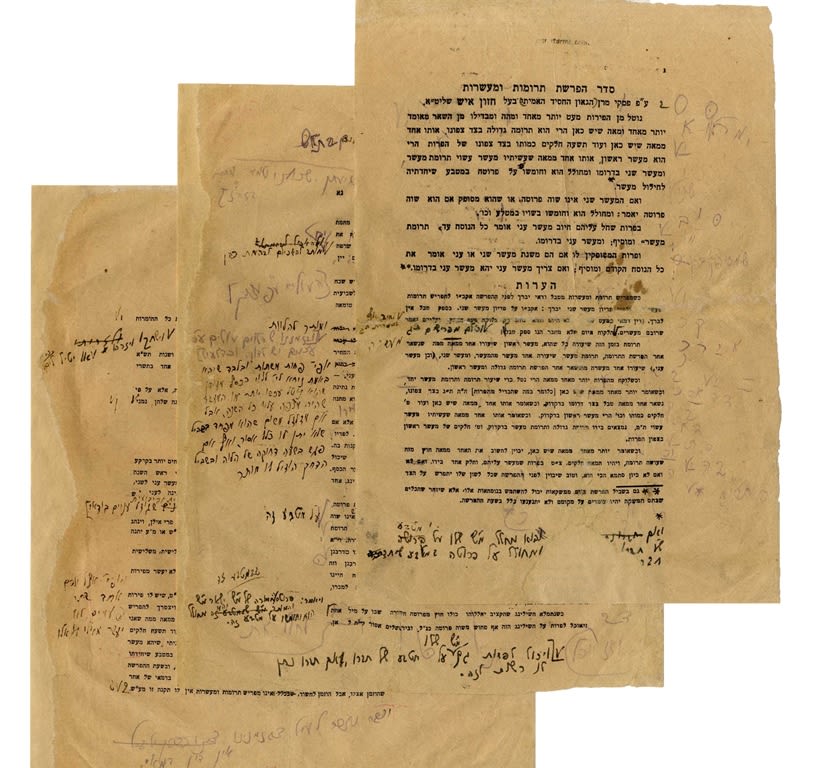
Comments in the hand of Rabbi Avraham Yeshaya Karelitz, the Chazon Ish, on the “Seder Hafrashat Terumot U’Maasrot al pi Piski HaChazon Ish” (Order for separating termuot and maasrot according to the halachic decisions of the Chazon Ish.) Printed proofs with many supplements, erasures and revisions in the hand of the Chazon Ish. [1940].
Specifications: [3] leaves – proofs. 23×19 cm.
Unique features: These leaves bear dozens of erasures, revisions, changes and supplements, including lengthy sentences, many words added in parentheses, and sentences marked with an asterisk in the margins. All these corrections were written in the hand of the Chazon Ish, who was very punctilious in halacha for the community. The printed work included these revisions, corrections and supplements. Interestingly, the original printed title uses the honorific “HaGaon HaChassid HaAmiti” in its reference to the Chazon Ish. Here, on the proofs, the Chazon Ish put parentheses around the honorifics, indicating that they should not be printed. The first edition that was printed didn’t include these honorifics, instead, it just states, “according to the halachic decisions of the author of the Chazon Ish shlit”a.”
Background: The Chazon Ish helped reinvigorate observance of the Land-of-Israel-dependent-mitzvahs, particularly among the new yishuv. He was heavily involved in deciding the relevant application of these mitzvahs, since many of the prominent rabbis who recently settled in the Land of Israel were not experts in this area. His format for separating terumot and ma’asrot [tithes] is very well known, including the text recited during the act of separation. His text became the fundamental version and was printed in many editions at the end of the Kitzur Shulchan Aruch and many prayer books. This version is used in practical halachah to this day. These are proofs of the leaves printed at the end of a booklet of Hilchot Kilaim V’Arla that was arranged by the Agudah Youth Kibbutz in Kfar Saba. The Chazon Ish was heavily involved in deciding applicable halachic question for the Orthodox kibbutzim in Kfar Saba and Chafetz Chaim. There is a note at the beginning of the booklet that its content was reviewed by the Chazon Ish and his suggested changes and supplements were incorporated before the book was printed. Prior to the “Seder Hafrashat Terumot U’Maasrot” there is a note that the text was organized by [Rabbi Kalman Kahana] who arranged the booklet, and corrected by the Chazon Ish shlit”a.
Condition: Fine. The leaves were professionally restored, primarily in the blank margins. Light blemishes to a number of solitary words.
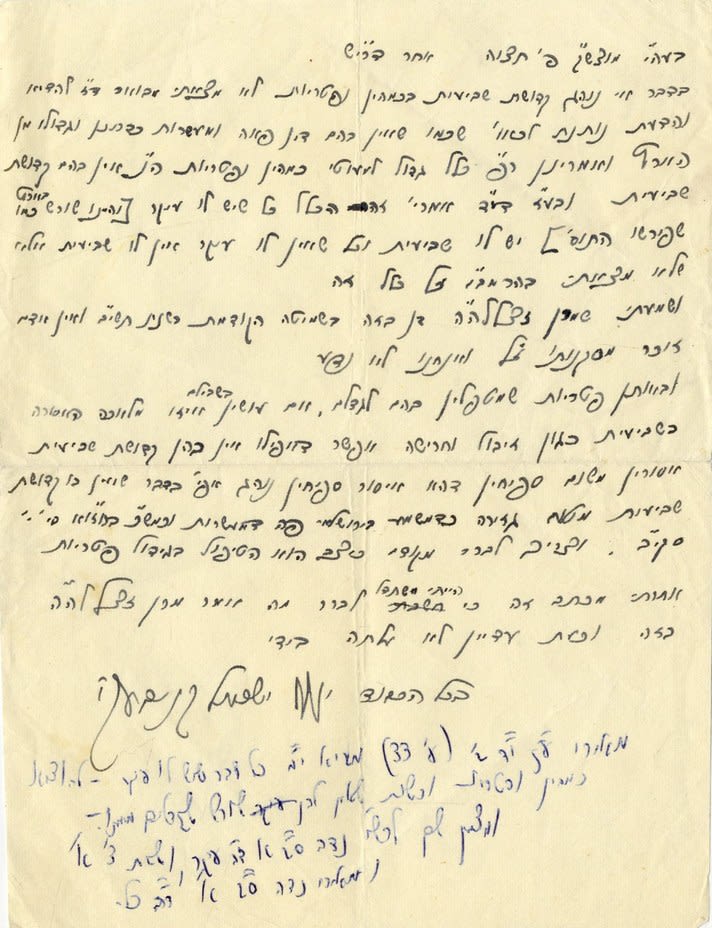
Halachic letter by Rabbi Yaakov Yisrael Kanievsky, the Steipler, in which he also discusses the opinion of the author of Chazon Ish [c. 1950s].
Specifications: [1] leaf, paper. 19×14 cm. Written and signed in his hand. Contains four lines of references that were added to the bottom of the page in a different handwriting.
Contents: Letter on the laws of Shemittah with regards to mushrooms and the manner in which they are grown during Shemittah. In the letter, Rabbi Kanievsky [brother-in-law to the author of Chazon Ish ] writes he heard that the Chazon Ish discussed this issue during the Shemittah year of 1952, but he is unaware of his conclusion. Once again at the letter’s close, he notes that he delayed his response because he tried to clarify the opinion of the Chazon Ish on the matter. [The year 1952 was the last Shemittah in the Chazon Ish’s life.]
Background: Rabbi Yisrael Yaakov Kanievsky (1899-1985) was a genius and righteous person. He was a leader of the charedi community and author of the series Kehillot Yaakov . He was called the “Steipler,” after the name of his hometown, Hornsteipl.
Condition: Very fine. Fold marks.
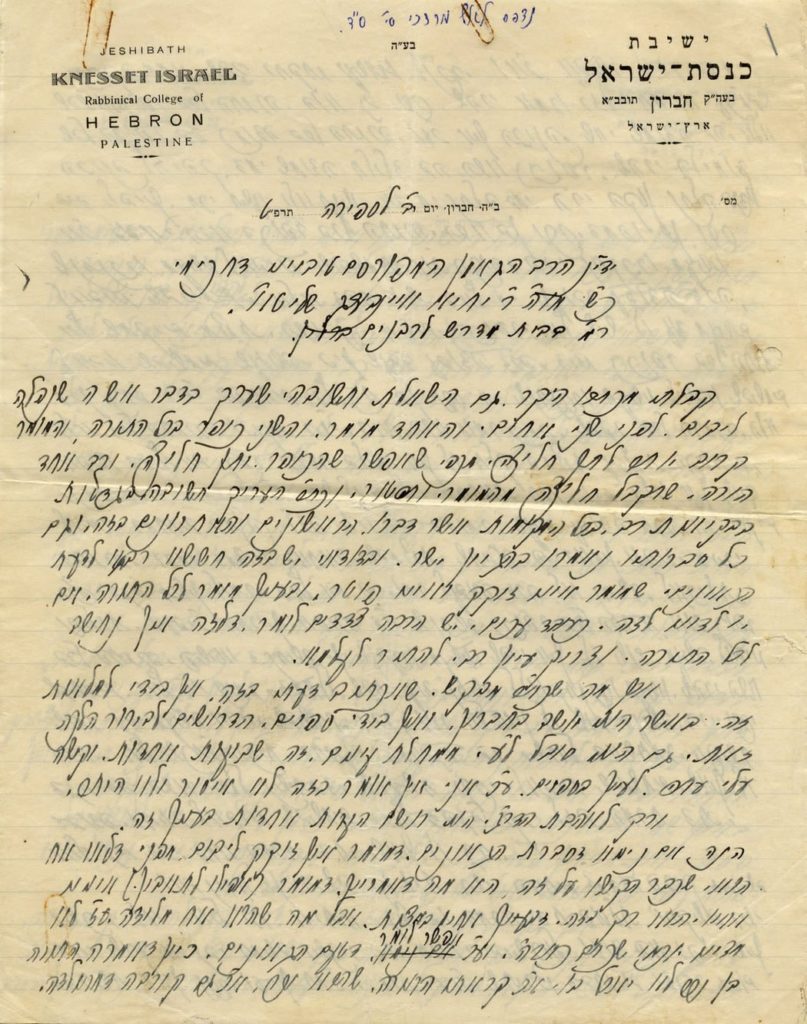
Long responsum from Rabbi Moshe Mordechai Epstein to Rabbi Yechiel Weinberg, head of the Rabbinical Seminary in Berlin, author of Sridei Esh . Hebron, 1929.
Specifications: [6] pages of paper, official letter paper of the Knesset Yisrael yeshiva in Hebron. 22×28 cm. Entirely in his handwriting and with his signature.
Unique Features: The responsum deals with chalitza performed by an apostate Jew and by one who disbelieves the entire Torah.
At the beginning of the responsum, Rabbi Moshe Mordechai Epstein writes that he is in Hebron and does not have enough books with him, and is also not in a good state of health, and can therefore not rule the halacha on this topic, but will write comments on the matter due to his love for the questioner. The responsum was printed in ShU”T Levush Mordechai 64.
Background: Rabbi Moshe Mordechai Epstein was born in 1866. He studied in the Volzhin Yeshiva, where he was considered a genius. After the passing of the well-known philanthropist Shraga Feivel Frank, his widow wanted to fulfill his will and to marry their daughters to great Torah scholars. She selected Rabbi Moshe Mordechai Epstein at the recommendation of the Netziv. He was asked by the Alter of Slabodka to serve as rosh yeshiva of Knesset Yisrael. He was also active in the Council of Torah Sages. Due to the decree drafting yeshiva students into the army, the yeshiva was transferred to the city of Hebron in the Land of Israel in 1924. He was extremely weakened by the massacres of 1929 and passed away in 1934. He wrote the Levush Mordechai series of books.
Condition: Fine. Binder holes damage a few letters. Tiny tears without lack.
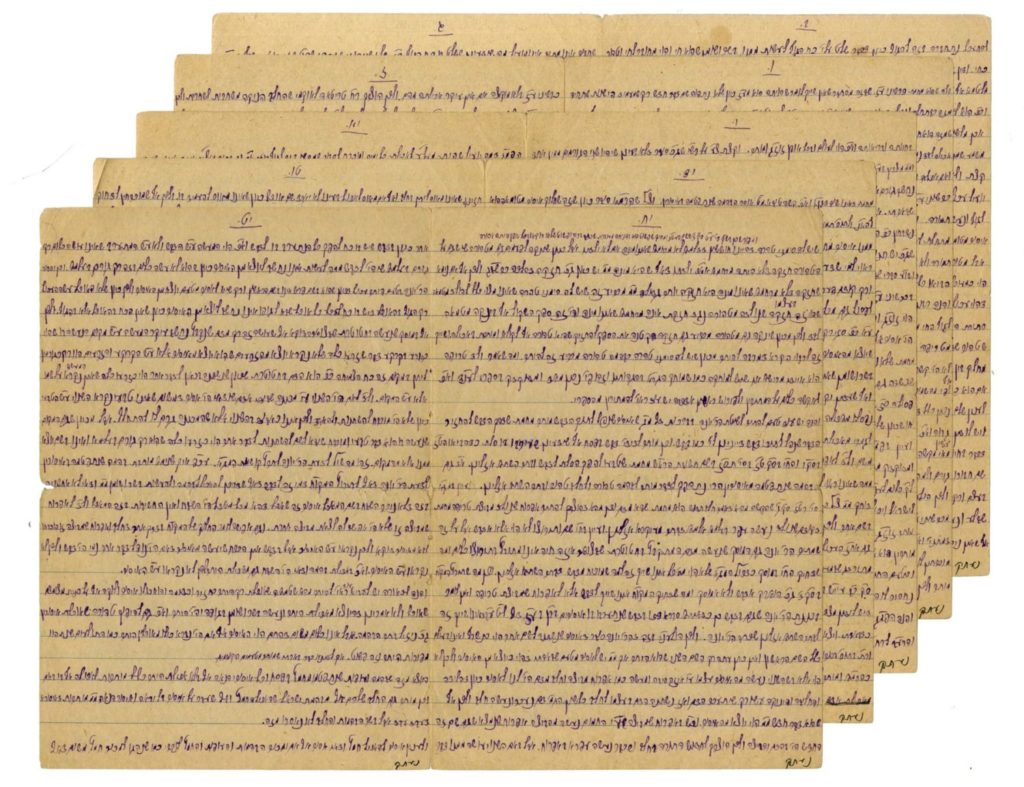
Extremely long halachic response regarding chickens that eat chametz and are then slaughtered for Passover consumption and the milk of animals that eat chametz on Passover. The response was written when Rabbi Moshe Feinstein served as rabbi of Lyuban, Russia, and was sent to his brother-in-law, Rabbi Reuven Leibowitz. Lyuban, [1935].
Specifications: 20 pages, lined paper. 14×21 cm. All in his hand and with his signature. Clear, legible handwriting.
Background: Rabbi Moshe Feinstein starts the letter by writing, “since this is a very profound issue, and our rabbis, the later scholars, did not scrutinize this adequately, I will clarify the issue, and explain the words of our rabbis, how in my humble opinion it should be ruled for practical application, and Hash-m should help that we not fail in halachic matters.” He ends by writing that he studied this issue in his days of wretched poverty. This response is printed in Shu”t Iggrot Moshe [section one, siman 147] and was divided into seven parts [leaves 249-261].
Rabbi Moshe Feinstein [1895-1986] was a prominent halachic adjudicator after the Holocaust. He was the president of Agudat Yisrael’s Council of Torah Sages in the United States and the Rosh Yeshiva of Metivtah Tiferet Yerushalayim in New York. He was famed for his Shu”t Iggrot Moshe series.
Condition: Very fine. Not bound.

Semicha from Rabbi Shalom Mordechai HaKohen Schwadron, the Maharsham of Berezhany, given to Rabbi Shalom Moskowitz, the Admor of Shatz. Berezhany, 1901.
Specifications: [1] doubled leaf. 26×21 cm.
Unique features: The semicha was written, signed and stamped by the Maharsham. It was given after Rabbi Shalom Moskowitz lived in his house for nine months to learn practical halacha. The Maharsham extols Rabbi Shalom’s approach to halacha extensively, and he taught him things that he did not wish to publicize in writing. He gave Rabbi Shalom semicha to be a rabbi-posek when he was only 24 years old. He writes: “He is worthy of being accepted as rabbi in every place reached by the words of the King of the world, his rulings are to be relied upon like every outstanding rabbi’s.” Despite their great difference in age, Rabbi Shalom Moskowitz is often considered the leading disciple of the Maharsham.
Background: Rabbi Shalom Mordechai HaKohen Schwardron, the Maharsham of Berezhany (1835-1911) was a prominent Galician rabbi and posek of his time. He had close relationships with leading Admors, and the Admors of Belz considered him the primary posek. Many questions were sent to him from around the world, and his questioners included the Chofetz Chaim. His printed works include the Shu”t Maharsham, which includes thousands of halachic responses, his large halachic treatises Da’at Torah, and many other works.
Rabbi Shalom Moskowitz of Shatz [1877-1958] was born in Shatz, Romania. He was a scion of the Maggid of Zolotchov. He was proficient in kabbala and halacha and authored halachic works. In his youth, he received semicha from the Maharsham who praised him extensively. In 1929, he moved to London where he was known as the “Admor of Shatz” and was a reputed wonder-worker. In his will, he promised to arouse Divine pity for anybody who prayed at his grave and took upon himself to fortify his mitzvah observance and light candles. His grave became a pilgrimage site, primarily on Fridays. Some of his Torah thoughts were printed in the Da’at Shalom series. Refer to: Encyclopedia L’Chassidut, 3, 661-662.
Condition: Light tears in the folds, lightly affecting text. Fine condition.
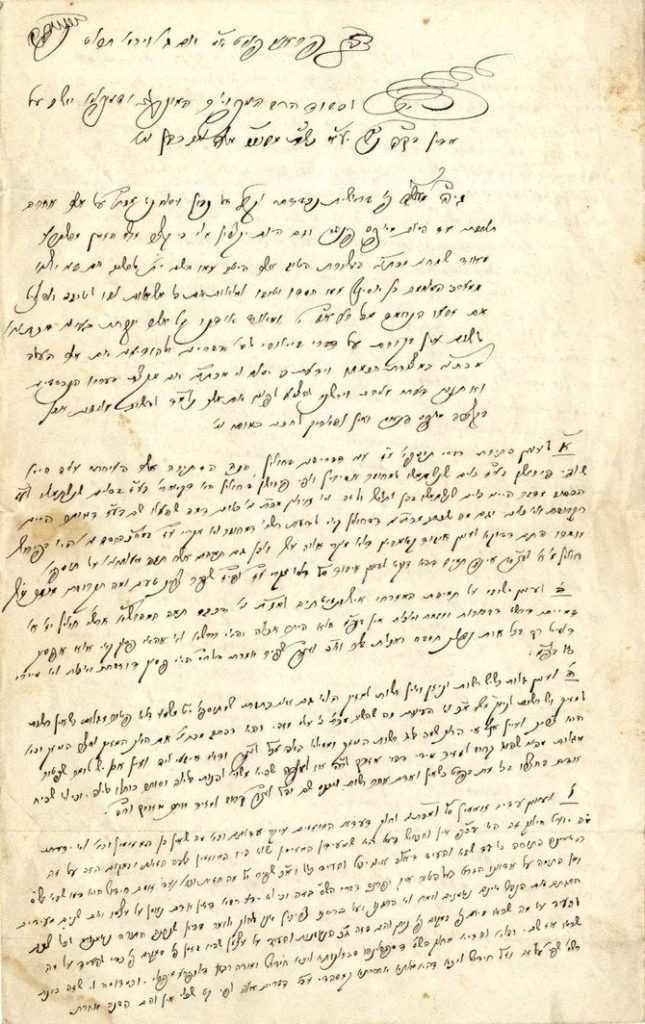
Lengthy letter written by Rabbi Samson Refael Hirsch, sent as a response to Rabbi Moshe Leib Cohen of Nikolsburg. The letter focuses on Torah thoughts and ends with a clause regarding the fundamentals of the Torah, as a response to his opponents. Frankfurt, [1878].
Specifications: [3] pages, 22×14 cm. The letter was sent to Rabbi Moshe Leib Cohen, Av Beit Din of Nikolsburg and prominent disciple of Rabbi Yehuda Assad. Rav Hirsch begins the letter with effusive honorifics. The entire letter is in Hebrew, in Rav Hirsch’s handwriting, and is signed at the conclusion: הק’ שמשון בן לא”א כמה”ו רפאל הירש פ”פ זצ”ל”.
Unique features: Lengthy letter full of Torah ideas. In the last section, Rav Hirsch discusses the words of the gemara (Megilla 3), “Torah megilla megilla nitna oh Torah chatuma nitna,” and the Ramban’s discussion of this phrase in his introduction to his commentary on the Torah. In his letter, Rav Hirsch thanks Rabbi Moshe Leib of Nikolsburg and notes that what he wrote fortifies his position and he did not stray from the path of truth. He adds that he is very pained by those who oppose his opinion in this matter (!). Igrei Dibei Hilulei (2004) includes a short letter that Rav Hirsch sent to Rabbi Moshe Leib Cohen. However, this is a lengthy, three-paged letter. Rav Hirsch’s Hebrew letters are especially rare.
Background: Rabbi Samson Refael Hirsch (1808-1888) fashioned the “Torah im Derech Eretz” stream of Orthodoxy in Germany. He was a prime opponent of the Reform movement that was spreading at the time to many Jewish communities throughout Germany. When Rav Hirsch was appointed Rabbi of Frankfurt am Main in 1851, he started working to improve and fortify the spiritual condition of Jewish youth. He focused on founding a Jewish school where the students could acquire a Torah and secular education. Rav Hirsch used his many writings (written in German to increase their readership) to pave a path to the hearts of Jewish youth and enable them to overcome the spiritual challenges of the time. He noted in his introduction to his essay: “To fill all spirits and souls with the thoughts of David.”
Condition: Very fine. Minimal aging stains, fold marks.
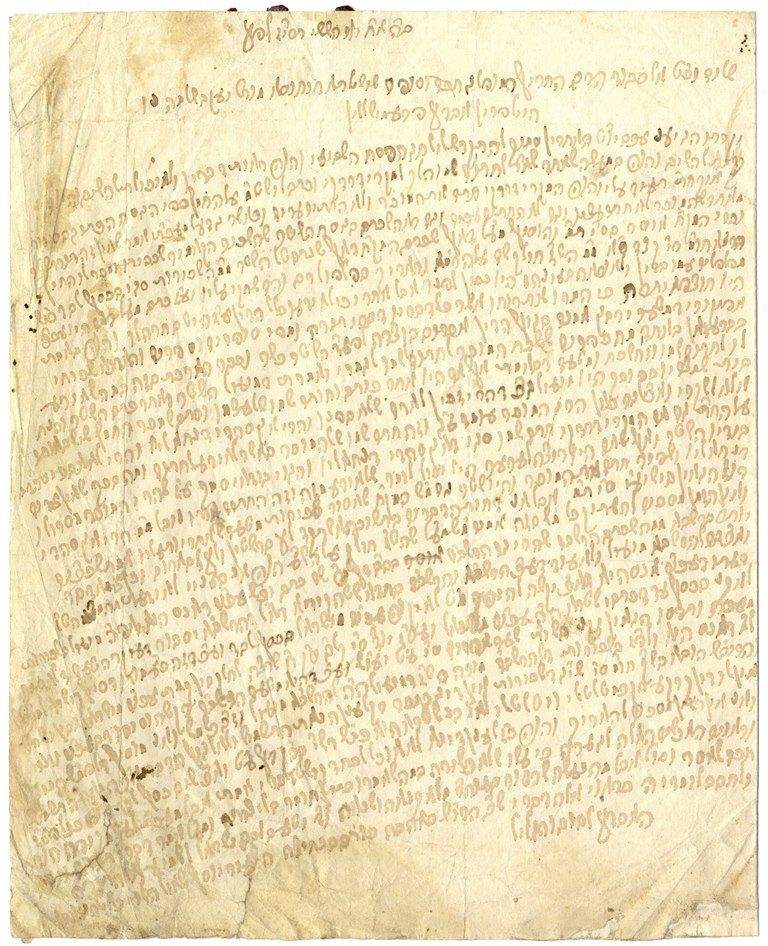
Autograph of Rabbi Yosef Shaul Notenhausen, Av Beit Din of Lemberg, author of Shoel U’Meishiv , [Lemberg], [1857].
Specifications: [1] doubled leaf, 21×17 cm. The response was written and signed by the author of Shoel U’Meishiv . It was written to Rabbi Yaakov Shlomo, Av Beit Din of Premishlan, and its content includes a section of a question from Shoel U’Meishiv , second edition. The response appears on one page, and the second page bears the address of the sender, a stamp and traces of a red wax stamp.
Unique features: Response regarding selling chametz and renting the location with the chametz to a non-Jew, accomplished without witnesses and without the seller writing his name in the contract.
Background: The great gaon, Rabbi Yosef Shaul HaLevi Notenhausen, author of Shoel U’Meishiv (1808-1875) was the rabbi of Lemberg for about twenty years. He was a master of Torah and one of the leading halachic responders of his time. He received questions from all corners of the world. He was asked to provide many approbations and rabbinic semicha. He was known to be “holy from the womb” and was admired by the Torah leaders of his generation – including the Chatam Sofer – from a very young age. When Rabbi Chaim of Sanz addressed a question to him regarding mikvaot, he used many honorifics ( Shu”t Shoel U’Meishiv, second edition, section 1, siman 24).
Condition: Moderate-fine. Fold marks. Aging stains. The ink has faded but is legible. Light tears without loss of text.

Letter from Rabbi Refael Shapiro, Rosh Yeshiva of Volozhin, sent to the Av Beit Din of Jerusalem, his disciple Rabbi Aryeh Levin and his sick son, Rabbi Menachem Zundel [1905-1908?], with a supplement by his wife in her handwriting.
Specifications: [1] leaf, graph paper. 20×13 cm. Text on both sides of the leaf, all in Rabbi Refael’s handwriting, signed twice by him.
Content: In his letter, he sends regards to Rabbi Chaim Yaakov Shapiro, Av Beit Din in Jerusalem, and to the son-in-law of Rabbi Chaim Yaakov’s son, a reference to Rabbi Aryeh Levin who studied with him in Volozhin in his youth. Rabbi Refael warmly blesses them: “May Hashem give you all the requests of your hearts for good…” Later, he adds a blessing for his son Rabbi Zundel who was ill, “Hashem should strengthen and fortify him…” Rabbi Zundel moved to Jerusalem and passed away in 1908, during his father’s lifetime. The margins feature an emotional plea in Yiddish, in pen, in a different handwriting, apparently that of Rabbi Refael Shapiro’s wife, Rabbi Zundel’s mother.
Background: Rabbi Refael Shapiro was born in [1837]. His father was Rabbi Aryeh Leib Shapiro, Rabbi of Kovno, known as “Rabbi Leibel Kovner.” In 1852, he married the daughter of the Netziv and in 1870 was appointed deputy Rosh Yeshiva of Volozhin. In 1881, he gave up his position to Rabbi Chaim Soloveitchik of Brisk and was appointed Rabbi of Novoalexandrovsk in Lithuania, and afterwards in Brisk.
Condition : Restored tears and tape marks. The text is all legible. Moderate condition.